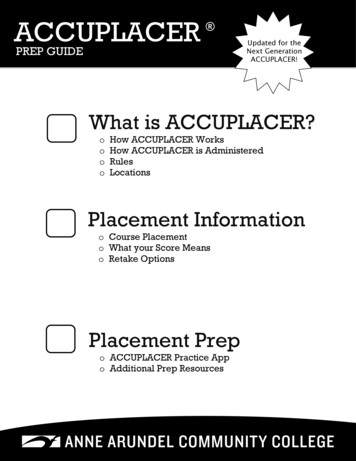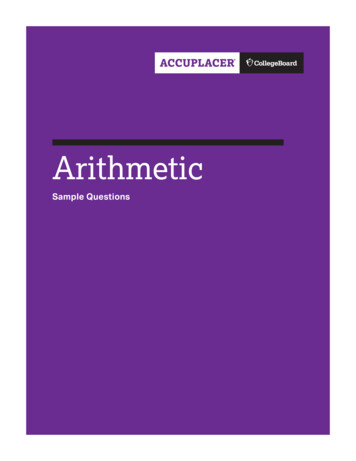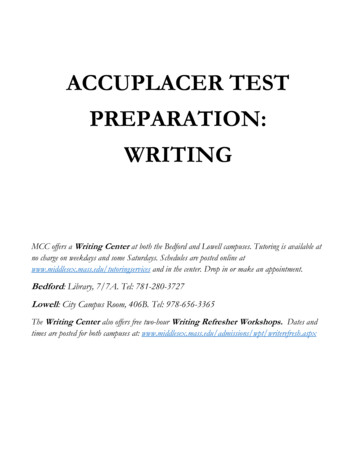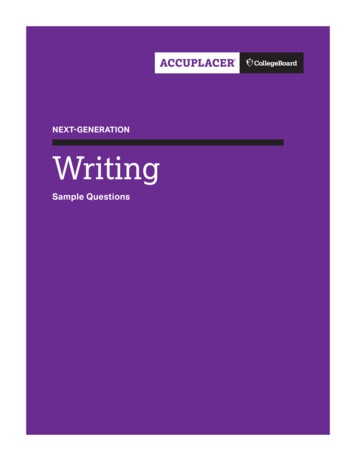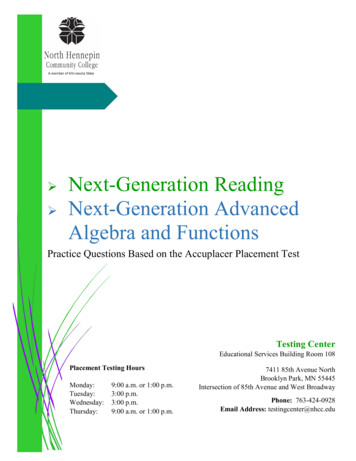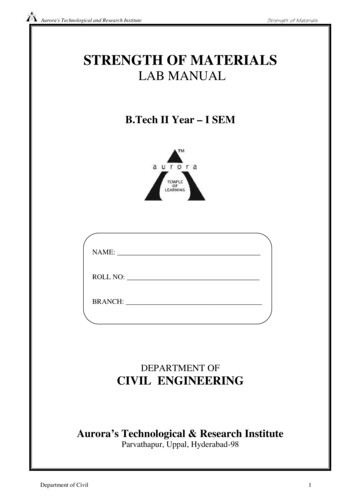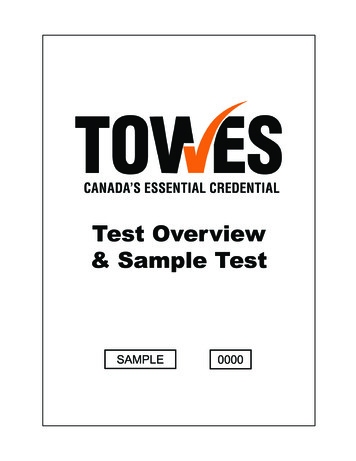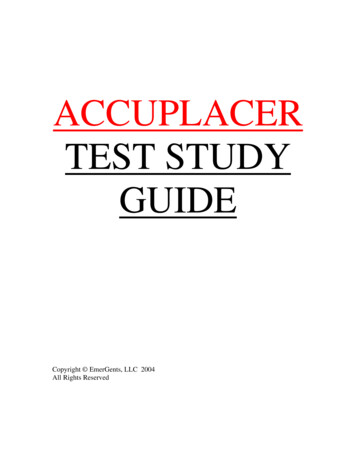
Transcription
ACCUPLACERTEST STUDYGUIDECopyright EmerGents, LLC 2004All Rights Reserved
ENGLISH GRAMMER AND USAGEThe following list of English Grammar Rules and their Usage Rules are essential for youto know. You must be familiar with these rules if you want to score well in this area ofthe test.Capitalization1. Capitalize the first word of a sentence.2. Capitalize all proper names.Example: Russia, United Methodist Church, Dan Marino.3. Capitalize days of the week, months of they year, and holidays.Example: The package was mailed on Tuesday, the day after Easter.Note: Do NOT capitalize seasons.Example: In Hawaii, summer is hot.4. Capitalize the first and all other important words of a title.Example: The Art of a Blacksmith5. Capitalize nouns that are not regularly capitalized when they are used as part of propernames.Example: Tomorrow, I am going to visit Aunt Mary, my favorite aunt.Example: Tiger Avenue is a very wide avenue.6. Capitalize the points of the compass only when referring to a direction.Example: Many people enjoy country food in the South.Note: Do NOT capitalize the points of the compass when referring to direction.Example: Many geese head south in the fall.
7. Capitalize languages and specific place names used as modifiers. Do not capitalizeany other school subjects.Example: In two years, I will take German, astrology, English literature,geometry,American history, and ancient cultures.8. Capitalize the first word of a direct quotation.Example: It was Martin Luther King who said, “I have a dream.”Note: Do NOT capitalize the first word within quotation marks if it does not begin acomplete sentence, when a directly quoted sentence is broken.Example: “I hit my head,” he told us, “because the cabinet was left open.”PunctuationThe Apostrophe1. Use an apostrophe to indicate possession. Place the apostrophe according to this rule:“The apostrophe, when used to indicate possession, means belonging to everything tothe left of the apostrophe.”Examples: man’s belonging to the manmen’s belonging to the menchildren’s belonging to the childrenNote: To test for correct placement of the apostrophe, read “of the.”Example: childrens’ of the children (clearly incorrect)The placement rule applies at all times, even with regard to compound nounsseparated by hyphens and with regard to entities made up of two or more names.Example: son-in-law’s belonging to a son-in-lawExample: Morris, Benson, and Smith’s law firm the law firm belonging to Morris,Benson, and SmithExample: Gomez and Son’s delivery truck the delivery truck of Gomez and Sons
2. Use an apostrophe in a contraction in place of the omitted letter or letters.Examples: haven’t have notwe’re we arelet’s let uso’clock of the clockclass of ’85 class of 1985Note: Do NOT start a paragraph with a contraction that begins with an apostrophe.3. Use an apostrophe to form plurals of numbers, letters, and phrases referred to aswords.Example: The child pronounced his t’s as b’s.Example: Solution of the puzzle involves crossing out all the 3’s and 9’s.Example: Her speech was plagued with you know’s.The Colon1. Use a colon after the salutation in a business letter.Example: Dear Committee Member:2. Use a colon to separate hours from minutes.Example: The sun rose at 6:01 P.M.3. Use of the colon is optional in the following cases:(a) to introduce a list, especially after an expression such as follows(b) to introduce a long quotation(c) to introduce a questionExample: My question is this: Are you interested in the job?The Comma1. Use a comma after a salutation of a personal letter.Example: Dear Joe,
2. Use a comma after a complimentary close to a letter.Example: Sincerely,3. Use a comma or pair of commas to set off a noun of address.Example: When you finish washing your car, Mike, please sweep the porch.4. Use a pair of commas to set off an appositive, a phrase that follows a noun or pronounand means the same as that noun or pronoun.Example: Mr. Jones, our designer, did an excellent job.5. Use a pair of commas to set off parenthetical expressions, words that interrupt theflow of the sentence, such as however, though, for instance, by the way.Example: We could not, however, get her to disagree.Example: The movie, I believe, is the best of its time.Note: Test for placement of commas in a parenthetical expression by reading aloud.If you would pause before and after each such expression, then it should be set off bycommas.6. Use a comma between two or more adjectives that modify a noun equally.Example: The young, nervous, second-grade teacher stood at the front of his class of34 seven-year-olds.Note: If you can add the word and between the adjectives without changing the senseof the sentence, then use commas.7. Use a comma to separate words, phrases, or clauses in a series. The use of a commabefore and is optional. If the series ends in etc., use a comma before etc. Do not usea comma after etc. in a series, even if the sentence continues.Example: Gloves, umbrellas, and shoes should be placed in the closet down the hall.Example: Rules, pens, notebooks, etc. belong in your office drawer.8. Use a comma to separate a short direct quotation from the speaker.Example: He said, “I want to drive my car today.”Example: “Tomorrow I am going dancing,” she told us.
9. Use a comma after an introductory phrase of five or more words.Example: Because the prisoner had a history of attempted jailbreaks, he was put in anarea with maximum security.10. Use a comma after a short introductory phrase whenever the comma would aidclarity.Example: As a child he was playful. (no comma needed)Example: To Paul, Joe was a friend as well as a co-worker. ( comma helps to clarify)Example: In 1934, 400 people lost their lives in a single air disaster. (comma helps toclarify)Note: A comma in not generally used before a subordinate clause that ends asentence, though in long, unwieldy sentences like this one, use of such comma isoptional.11. Use a comma before a coordinating conjunction unless the two clauses are very short.Example: The man wanted to bail his friend out of jail, but the corrections officerwould not allow him to take his friend until he had paid the fine.Example: Luke washed the car and Bob dried.12. Use a pair of commas to set off a nonrestrictive adjective phrase or clause. Anonrestrictive phrase or clause is one that can be omitted without essentially changingthe meaning of the sentence.Example: Our new car, which has bright red stripes, is very sporty.A restrictive phrase or clause is vital to the meaning of a sentence and cannot beomitted. Do NOT set if off with commas.Example: A car without wheels is useless.13. Use a comma if a sentence might be subject to different interpretations without it.Example: The banks which closed yesterday are in serious financial difficulty.(Some banks closed yesterday, and those banks are in trouble.)The banks, which closed yesterday, are in serious financial difficulty.(All banks closed yesterday, and all are in trouble.)
Example: My sister Jill is getting divorced.(The implication is that I have more than one sister.)My sister, Jill, is getting divorced.(Here Jill is an appositive. Presumably she is the only sister.)14. Use a comma if a pause would make the sentence clearer and easier to read.Example: Outside the people were eating. (confusing)Outside, the people were eating. (clearer)Example: After all debts must be paid. (confusing)After all, debts must be paid. (clearer)The pause rule is not infallible, but it is your best resort when all other rulesgoverning use of the comma fail you.The Dash1. Use a dash - or parentheses - for emphasis or to set off an explanatory group ofwords.Example: The tools of his trade – wrench, hammer, nails - were neatly arranged onthe work bench.Note: Unless the set-off expression ends a sentence, dashes, like parentheses, must beused in pairs.2. Use a dash to break up a thought.Example: There are six - remember, I said six – good men in our patrol squad.3. Use a dash to mark sudden break in thought that leaves a sentence unfinished.Example: She opened the door a crack and saw –The Exclamation Mark1. Use an exclamation mark only to express strong feeling or emotions, or to implyurgency.Example: Congratulations! You broke the record.Example: Rush! Perishable contents.
The Hyphen1. Use a hyphen to divide a word at the end of a line. Always divide words betweensyllables.2. Use a hyphen in numbers from twenty-one to ninety-nine.3. Use a hyphen to join two words serving together as a single adjective before a noun.Example: We left the highway and proceeded on a well-paved road.Example: That baby-faced man is considerably older than he appears to be.4. Use a hyphen with the prefixes ex-, self-, and all-, and the suffix –elect.Examples: ex-Senator, self-appointed, all-state, Governor-elect5. Use a hyphen to avoid ambiguity.Example: After the soldier recovered the use of his right leg, he re-covered the officechairs.6. Use a hyphen to avoid an awkward union of letters.Example: semi-independent, shell-likeThe Period1. Use a period at the end of a sentence that makes a statement, gives a command, ormakes a “polite request” in the form of a question that does not require an answer.Example: I am preparing for my test.Example: Proofread everything you type.Example: Would you please hold the script so that I may see if I have memorized mylines.2. Use a period after an abbreviation and after the initial in a person’s name.Example: Lt. McGee led the soldiers into the war zone.Note: Do NOT use a period after postal service state name abbreviations such as AZ(for Arizona) or MI (for Michigan).
The Question Mark1. Use the question mark after a request for information.Example: At what time does the last bus leave?Note: A question must end with a question mark even if the question does notencompass the entire sentence.Example: “Daddy, are we there yet?” the child asked.Quotation Marks1. Use quotation marks to enclose all directly quoted material. Words not quoted mustremain outside the quotation marks.Example: “If it is cold on Saturday,” she said, “we will stay inside to eat.”Note: Do NOT enclose an indirect quote in quotation marks.Example: He said that we would probably eat inside on Saturday.2. Use quotation marks around words used in an unusual way.Example: A surfer who “hangs ten” is performing a tricky maneuver on a surfboard,not staging a mass execution.3. Use quotation marks to enclose the title of a short story, essay, short poem, song, orarticle.Example: Bruce David Williamson wrote a plaintive poem called “The DarkStreets.”Note: Titles of books and plays are NOT enclosed in quotation marks. They areprinted in italics. In handwritten or typed manuscript, underscore titles of books andplays.Example: The song “Tradition” is from Fiddler on the Roof.
Placement of Quotation Marks1. A period ALWAYS goes inside the quotation marks, whether the quotation marks areused to denote quoted material, to set off titles, or to isolate words used in a specialsense.Example: The principle said, “Cars parked in the fire lane will be ticketed.”Example: The last chapter of The Wild Witch is entitled “Spells of the Ocean.”Example: Pornography is sold under the euphemism “adult books.”2. A comma ALWAYS goes inside the quotation marks.Example: “Lets get out of here,” said the resort guests.Example: If your skills become “rusty,” you must study before you take the exam.Example: Three stories in John Henson’s The Sparks Fly High are “Run Fast Cars,”“Killer Instinct,” and “Maybe Tomorrow.”3. A question mark goes inside the quotation marks if it is part of the quotation. If thewhole sentence containing the quotation is a question, the question mark goes outsidethe quotation marks.Example: He asked, “She the train on time?”Example: What did you really mean when you said “Absolutely not”?4. An exclamation mark goes inside the quotation marks if the quoted words are anexclamation; it goes outside if the entire sentence, including the quoted words, is anexclamation.Example: The cop shouted, “Drop your weapon!”Example: Help us fight our “friends”!5. A colon and a semicolon ALWAYS go outside the quotation marks.Example: She said, “Flowers are beautiful”; he added, “Guns are beautiful.”6. When a multiple-paragraph passage is quoted, each paragraph of the quotation mustbegin with quotation marks, but ending quotation marks are used only at the end ofthe last quoted paragraph.
The Semicolon1. Use a semicolon to separate a series of phrases or clauses, each of which containcommas.Example: The old gentleman’s heirs were Joanne Nichols, his half-sister; JoeyPatterson, the chef; Michael Johnson, companion of his late cousin, Max Williams;and his favorite charity, the United Way.2. Use a semicolon to avoid confusion with numbers.Example: Add the following: 4.17; 2.07; and 13.21.3. You may use a semicolon to join the two short, related independent clauses.Example: Susan is working at the cash register on Wednesday; Martin will take overon Thursday.Note: Two main clauses must be separated by a conjunction or by a semicolon, orthey must be written as two sentences. A semicolon never precedes a coordinatingconjunction. The same two clauses maybe written in any one of the three ways:Example: Autumn had come, and the trees were almost bare.Autumn had come; the trees were almost bare.Autumn had come; The trees were almost bare.4. You may use a semicolon to separate two independent clauses that are joined by anadverb such as however, therefore, otherwise, or nonetheless. The adverb must befollowed by a comma.Example: You may use a semicolon to separate this clause from the next; however,you will not be incorrect if you choose to write two separate sentences.Note: If you are uncertain about how to use the semicolon to connect independentclauses, write two sentences instead.Spelling Rules#1.i before eExcept after cOr when sounding like ayAs in neighbor or weighException: neither, leisured, foreigner, seized, weird, heights
#2.If a word ends in y preceded by a vowel, keep the y to when adding a suffix.Examples: day, days; attorney, attorneys.#3.If a word ends in y preceded by a consonant, change the y to i before adding asuffix.Examples: try, tries, tried; lady, ladies.Exception: To avoid double i, retain the y before –ing and –ish. For example, fly,flying; baby, babyish.#4.Silent e at the end of a word is usually dropped before a suffix beginning with avowel.Examples: dine ing dininglocate ion locationuse able usableoffense ive offensiveException: Words ending in ce and ge retain e before –able and –ous in order toretain the soft sounds of c and g. For example, peace able peaceable; courage ous courageous.#5.Silent e usually kept before a suffix beginning with a consonant.Examples: care less carelesslate ly latelyone ness onenessgame ster gamester#6.Some exceptions must simply be memorized. Some exceptions to the last two rulesare: truly, duly, awful, argument, wholly, ninth, mileage, dyeing, acreage,canoeing.#7. A one-syllable word that ends in a single consonant preceded by a single voweldoubles the final consonant before a suffix beginning with a vowel or y.Examples: hit, hitting; drop, dropped; big, biggest; mud, muddyBut: help, helping because help ends in two consonants; need, needing because thefinal consonant is preceded by two vowels.#8. A word with more than one syllable that accents the last syllable and ends in asingle consonant preceded by a single vowel doubles the final consonant whenadding a suffix beginning with a vowel.Examples: begin, beginner; admit, admitted.But: enter, entered because the accent is not on the last syllable.#9.A word ending in er or ur doubles the r in the past tense if the word is accented onthe last syllable.Examples: occur, occurred; prefer, preferred; transfer, transferred.
#10. A word ending in er does not double the r in the past tense if the accent does notfall on the last syllable.Examples: answer, answered; offer, offered; differ, differed.#11. When –full is added to the end of a noun to form an adjective, the final l is dropped.Examples: cheerful, cupful, hopeful.#12. All words beginning with over are one work.Examples: overcast, overcharge, overhear.#13. All words with the prefix self are hyphenated.Examples: self-control, self-defense, self-evident.#14. The letter q is always followed by u.Examples: quiz, bouquet, acquire.#15. Numbers from twenty-one to ninety-nine are hyphenated.#16. Per cent is never hyphenated. It may be written as one word (percent) or as twowords (per cent).#17. Welcome is one word with one l.#18. All right is always two words. There is no such word as alright.#19. Already means “prior to some specific time.” All ready means “ completely ready.”Example: By the time I was all ready to go to the play, the bus had already left.#20. Altogether means “entirely.”All together means “in sum or collectively.”Example: There are altogether too many people to seat in this room when we areall together.#21. Their is the possessive of they.There is the contraction for they are.There is “that place.”Example: they’re going to put their books over there.#22. Your is the possessive of you.You’re is the contraction for you are.Example: You’re certainly planning to leave your muddy boots outside.#23. Whose is the possessive of who.Who’s is the contraction for who is.Example: Do you know who’s ringing the doorbell or whose car is in the street?
#24. Its is the possessive of it.It’s is the contraction for it is.Example: It’s I who put its stamp on the letter.Improving Your Spelling Through Your Own PersonalProgramIf you have left yourself ample time to study for your exam, then you can go beyondmemorizing rules and answering practice exercises, and you can develop a personalprogram for improving your own spelling. Think of your own private “demons,” thewords that you must look up every time you write a note or letter, and the words thatgave you trouble all through school. Everyone has such words. Make a list of thesewords, correctly spelled. Add to the list words that you often look up, words of whichyou are just not sure. Keep adding to this list right up to exam day. Each day that youhave a bit of study time, type through the list three times. By typing your troublesomewords correctly, your hands and fingers will get used to the “feel” of the correct spelling,and your eye will become accustomed to seeing the words correctly spelled. Frequentrepetition will embed the correct spelling in your mind.How to Answer Synonym QuestionsWhen answering “synonym questions,” read each question carefully. If you know thatsome of the answer choices are wrong, eliminate them. From your answer choices thatseem possible, select the one that most nearly means the same as the given word, even ifit is a word that you don’t normally use. The correct answer may not be a perfectsynonym, but of those choices offered, it is the closest in meaning to the given word.Make up a sentence sing the given word. Then test your answer by putting it in the placeof the given word in your sentence. The meaning of the sentence should be unchanged.First answer the questions you know. You can come back to the others later.How to Answer Sentence Completion QuestionsRead each question carefully, looking at all the answer choices. Eliminate any answerchoices that seem obviously wrong. Of the remaining choices, select the one that bestcompletes the meaning of the sentence or passage given. Although more than one answermay make sense, the best choice will be the one that is most exact, appropriate, or likely,considering the information given in the sentence passage. To check yourself, read thesentence or passage through again, putting your answer in the blank. First answer thequestions you know. If you have trouble with a question, leave it and come back to itlater.
How to Navigate Through the Reading ComprehensionAreaIt would appear to the average person taking this exam, that the reading comprehension isadequately tested in the exam itself. Without being able to read and understand both thecomplex sets of directions and some of the tricky questions posed on some tests, failure isimminent. This test will test your ability to read a passage, understand the point beingmade, and answer questions based on what is said in the passage being read.This section and the practice questions that we have included in the pages that follow aredesigned to help you overcome any fears you may have about taking this part of theexam. If you follow the simple suggestions listed here and do the exercises in ourpractice exam that follows, you will know what to look for when reading the passages.You will also know what to expect to find in the reading comprehension questions. Youwill then be one step ahead of the game.A. Skim the passage to get a general idea of the subject matter and of the point that isbeing made.B. Reread the passage, paying attention to details and point of view. Be alert for theauthor’s hints as to what he or she thinks is important. Phrases such as “Notethat .,” “Of importance .,” and “Do you overlook .” Give clues to what thewriter is stressing.C. If the author has quoted material from another source, be sure that you understand thepurpose of the quote. Does the author agree or disagree?D. Carefully read the question or incomplete statement. Determine exactly what is beingasked. Watch for negatives or all-inclusive words, such as always, never, all, only,every, absolutely, completely, none, entirely, and no. These words can affect youranswer.E. Read all of the answer choices. Do not rush to choose the first answer that might becorrect. Eliminate those choices that are obviously incorrect. Reread the remainingchoices, and refer to the passage, if necessary, to determine the best answer.F. Avoid inserting your judgments into your answers. Even if you disagree with theauthor or spot a factual error in the passage, you must answer on the basis of what isstated or implied in the passage.G. Do not allow yourself to spend too much time on any one question. If looking back atthe passage does not help you to find or figure out the answer, choose from amongthe answers remaining after you eliminate the obviously wrong answers, and go on tothe next question or the next reading passage.
Understanding Verbal AnalogiesVerbal analogies test your understanding of word meanings and your ability to grasprelationships between words and ideas. There are various classifications of relationships,such as similarity (synonym), opposition (antonym), cause and effect, and sequence. Averbal analogy may be written in mathematical form (CLOCK : TIME ::THERMOMETER : TEMPERATURE) or expressed in words (CLOCK is to TIME asTHERMOMETER is to TEMPERATURE).A verbal analogy has four terms in two pairs. You may be presented with the firstcomplete pair, which establishes the relationship, and the first half of the second pairfollowed by a list of possible matches. Or, you may be given just the first pair and then aselection of paired terms from which you must find the pair that implies the samerelationship as the fair pair.1. Read each question carefully.2. Establish what the exact relationship is between the two terms in the sample pair.3. Study the selection of possible answers carefully, and eliminate any pairs that do notshare the same relationship as the sample pair.4. Read the remaining choices through again, this time substituting the key relationshipword from the sample pair (for instance, CLOCK measures TIME;THERMOMETER measures TEMPERATURE).5. Answer the easy questions first. You can come back to the others later.
Practice English TestCorrect UsageIn each of the following questions, there are four sentences. One of them isgrammatically incorrect. Mark the answer sheet with the letter of the INCORRECTsentence.1. (A) Everyone at camp must have his or her medical certificate on file beforeparticipating in competitive sports.(B) A crate of oranges were sent from Florida for all of the children in cabin 6.(C) Bruce and David’s room looks as if they were prepared for inspection.(D) Four miles is too far for an elderly person to walk.2. (A) The game over, the spectators rushed out on the filed and tore down the goalposts.(B) The situation was aggravated by disputes over the captaincy of the team.(C) Yesterday they lay their uniforms aside with the usual end-of-the-season regret.(D) It is sometimes thought that politics is not for the high-minded.3. (A) Masterson’s autobiography, as well as his poems, are familiar to many students.(B) A series of authentic records of American Indian tribes is being published.(C) The Smokies is the home of the descendants of this brave tribe.(D) Five dollars is really not too much to pay for a book of this type.4. (A) Being tired, I stretched out on a grassy field.(B) While we were rowing on a lake, a sudden squall almost capsized the boat.(C) Entering the room, a strange mark on the floor attracted my attention.(D) Mounting the curb, the empty car crossed the sidewalk and came to rest against abuilding.5. (A) The text makes the process of developing and sustaining a successful home zooappear to be a pleasant and profitable one.(B) The warmth and humor, the clear characterization of the Walmsey family, whichincludes three children, two dogs, and two cats, is such fun to read that thisreviewer found himself reading it all over again.(C) You will be glad, I’m am sure, to give the book to whoever among your youngfriends has displayed an interest in animals.(D) The consensus among critics of the children’s literature is that the book is wellworth the purchase price.
6. (A) Not one in a thousand readers take the matter seriously.(B) He was able to partially accomplish his purpose.(C) You are not as tall as she.(D) The young people began to realize how much she had done.7. (A) In the case of members who are absent, a special letter will be sent.(B) The visitors were all ready to see it.(C) I like Joe’s poem, “To a Stone in the Water.”(D) Mike told Todd that he was sure he seen it.8. (A) G. Nelson and Co. has a sale on sport shirts today.(B) Venetian blinds—called that although they probably did not originate inVenice—are no longer used as extensively as they were at one time.(C) She determined to be guided by the opinion of whoever spoke first.(D) There was often disagreement as to whom was the better Shakespearean actor,Henry or Shawn.Spelling TestIn each group of four words, one word is misspelled. Find the misspelled word, andmark its letter on your answer sheet.1. (A)(B)(C)(D)affordcloseinglatterheadache2. (A)(B)(C)(D)gravelartifishallodgelilies3. (A)(B)(C)(D)documenthandsomefrightenincorect4. (A)(B)(C)(D)atachedflakesdistributedcontinue
5. (A)(B)(C)(D)conducterchoiceparticularstreamline6. (A)(B)(C)(D)thunderspeakingrecreationrockey7. (A)(B)(C)(D)providedrunnersugestedprinciple8. (A)(B)(C)(D)throughoutsilensepoliticaloperation9. (A)(B)(C)(D)truthorganizedpotatoeproduction10. (A)(B)(C)(D)worriedspinachguiltsuceededSynonym TestSelect the word or phrase closest in meaning to the given word.1. retain(A) pay out(B) play(C) keep(D) inquire2. endorse(A) sign up for(B) announce support for(C) lobby for(D) renounce
3. intractable(A) confused(B) misleading(C) instinctive(D) unruly4. correspondence(A) letters(B) files(C) testimony(D) response5. obliterate(A) praise(B) doubt(C) erase(D) reprove6. legitimate(A) democratice(B) legal(C) genealogical(D) underworld7. deduct(A) conceal(B) withstand(C) subtract(D) terminate8. mutilate(A) paint(B) damage(C) alter(D) rebel9. egress(A) extreme(B) extra supply(C) exit(D) high price
10. horizontal(A) marginal(B) in a circle(C) left and right(D) up and down11. controversy(A) publicity(B) debate(C) revolution(D) revocation12. preempt(A) steal(B) empty(C) preview(D) appropriate13. category(A) class(B) adherence(C) simplicity(D) cataract14. apathy(A) sorrow(B) indifference(C) aptness(D) sickness15. tentative(A) persistent(B) permanent(C) thoughtful(D) provisional16. per capita(A) for an entire population(B) by income(C) for each person(D) for every adult
17. deficient(A) sufficient(B) outstanding(C) inadequate(D) bizarre18. inspect(A) disregard(B) look at(C) annoy(D) criticize19. optional(A) not required(B) infrequent(C) choosy(D) for sale20. implied(A) acknowledged(B) stated(C) predicted(D) hinted21. presumably(A) positively(B) helplessly(C) recklessly(D) supposedly22. textile(A) linen(B) cloth(C) page(D) garment23. fiscal(A) critical(B) basic(C) personal(D) financial
24. stringent(A) demanding(B) loud(C) flexible(D) clear25. proceed(A) go forward(B) parade(C) refrain(D) resumeSentence CompletionEach of the following sentences or passages contains a blank. Select the word or phrasethat will best complete the meaning of the sentence or passage as a whole.1. He was the chief of his uncle’s will. After taxes, he was left with aninheritance worth close to 20,000.(A) exemption(C) pensioner(B) beneficiary(D) contestant2. In view of the extenuating circumstances and the defendant’s youth, the judgerecommended .(A) conviction(C) a mistrial(B) a defense(D) leniency3. The basic concept of civil service is that where a public job exists, all those whopossess the shall have an opportunity to compete for it.(A) potential(C) qualifications(B) contacts(D) credits4. They would prefer to hire someone fluent in Spanish because the neighborhood inwhich the clinic is located is Hispanic.(A) imponderably(C) consistently(B) sparsely(D) predominantly5. The lover of democracy has an toward totalitarianism.(A) antipathy(C) empathy(B) attitude(D) idolatry6. The candidate’s was carefully planned; she traveled to six cities and spoke atnine rallies.(A) pogrom(C) adjournment(B) itinerary(D) apparition
7.
2. Use a comma after a complimentary close to a letter. Example: Sincerely, 3. Use a comma or pair of commas to set off a noun of address. Example: When you finish washing your car, Mike, please sweep the porch.
